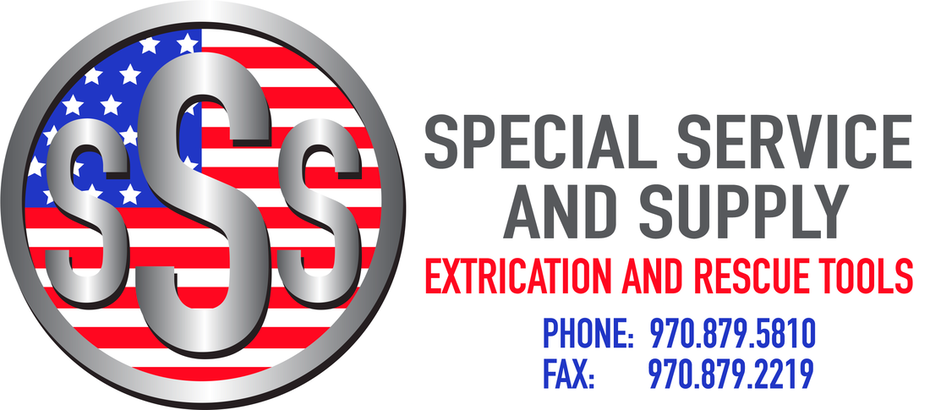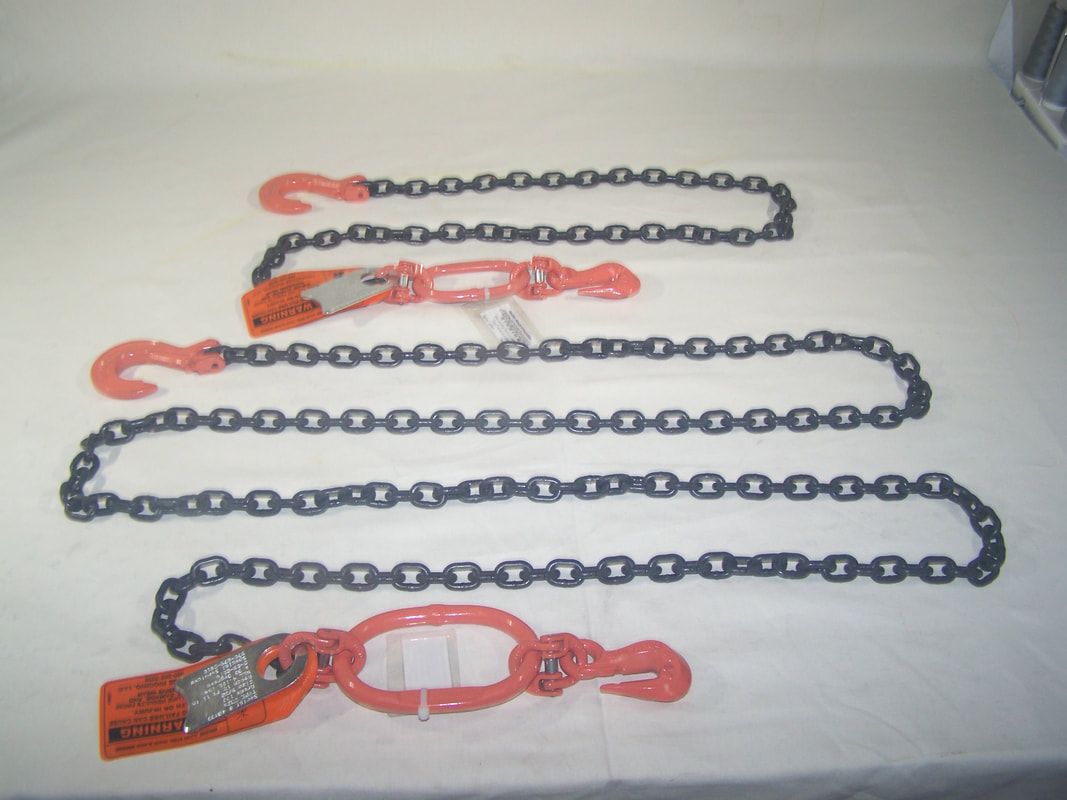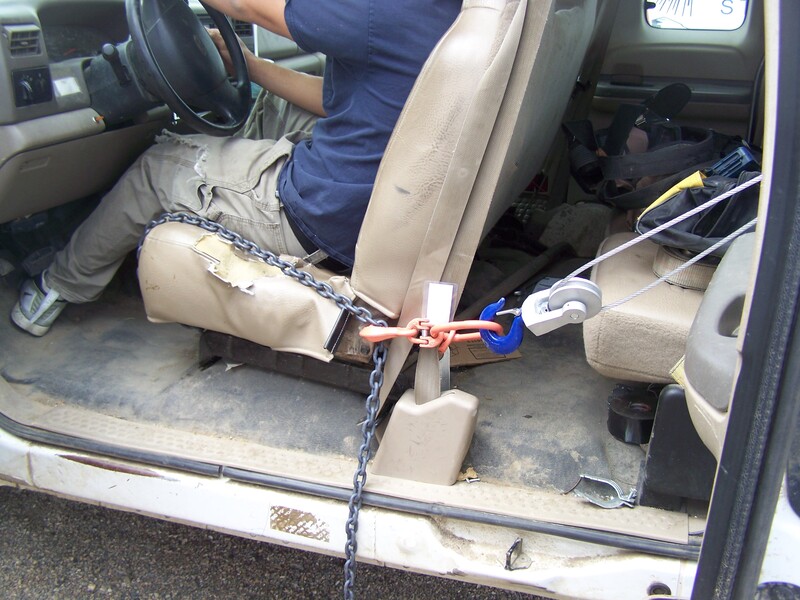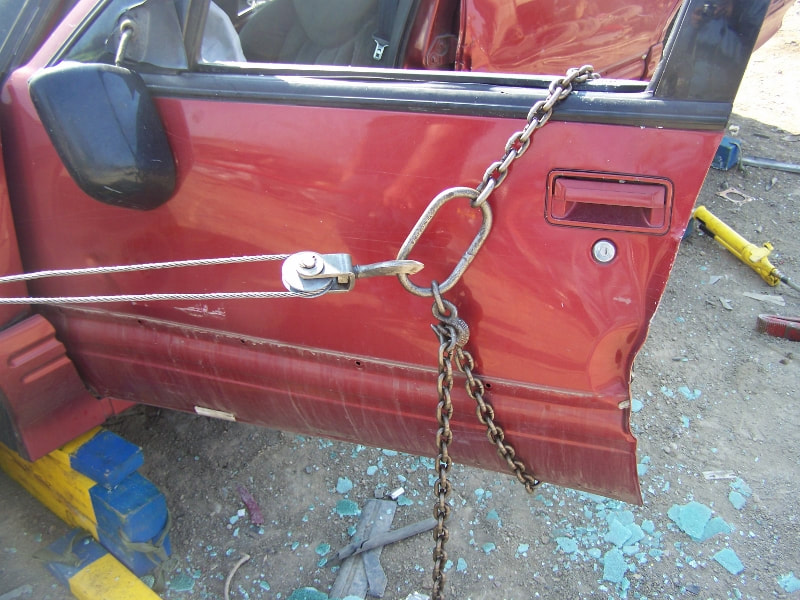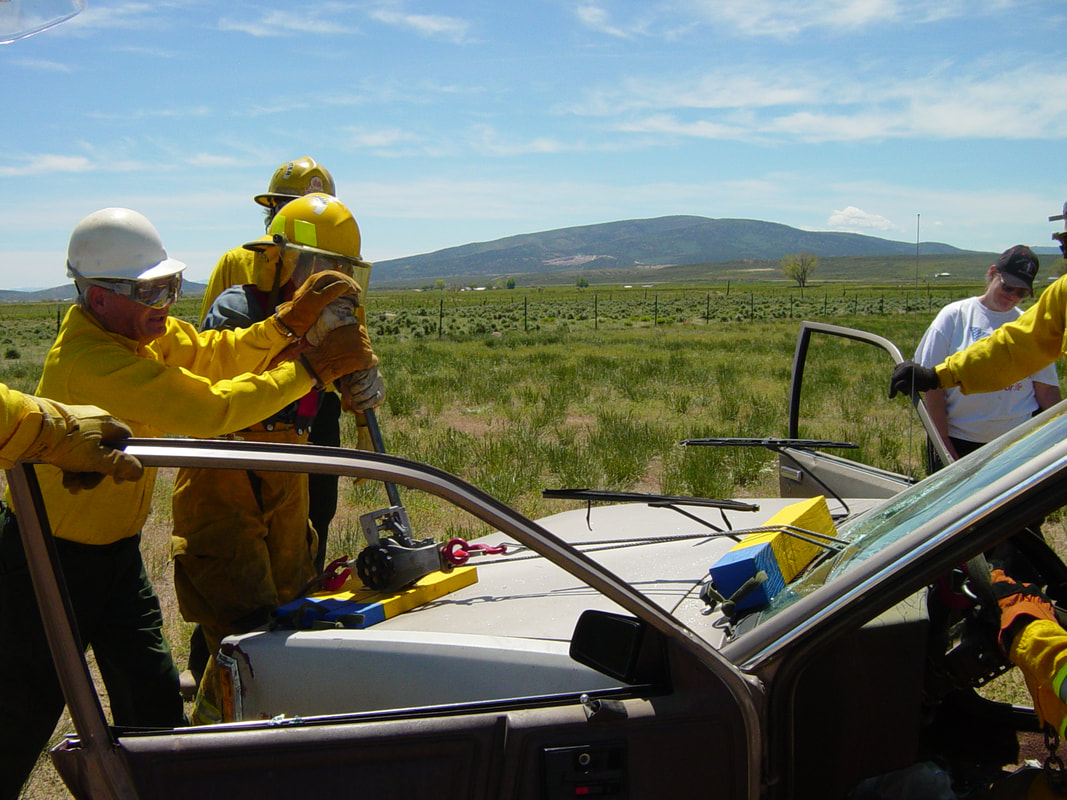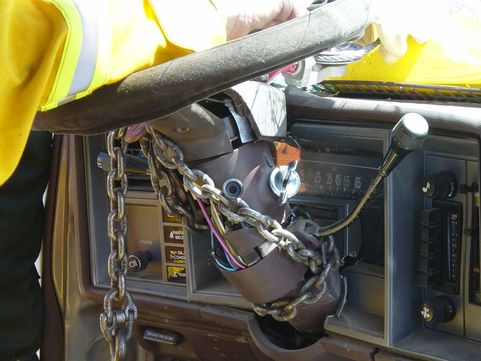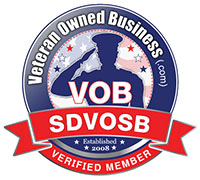CHAIN SLINGS MUST BE CONSTRUCTED OF HIGH QUALITY
MATERIALS
MATERIALS
GRADE 100 CHAIN SLINGs MUST BE CONSTRUCTED OF HIGH
QUALITY MATERIALS
CHArACTERISTICS OF GRADE 100 LIFTING CHAINS
CHArACTERISTICS OF GRADE 100 LIFTING CHAINS
Model C-1, Rescue Chain Set™, is comprised of two, special high strength Grade 100 chain slings, constructed from Grade 100 chain and grade 100 components to form a 5 foot chain assembly and a 12 foot chain assembly. Each chain assembly is constructed of a special herc alloy, heat treated 9/32”, Grade 100, highly flexible, high carbon alloy chain with grade 100 forged alloy steel rings, hooks and master links. A chain and attached master link, rings, hooks and permanently attached serial numbered identification tag is referred to as a chain sling. All of the components must be of similar ratings with the assembly is rated to the capacity of the weakest component.
Chain slings in the Model C-1 RESCUE CHAIN SET are provided with a permanently attached metal identification tag bearing the assemblies unique Serial Number, Chain Grade, Chain Size, Working Load Limit, Date of Manufacture, Manufacturer's Name and Phone Number. A "Chain Inspection Guide", "Operation and Maintenance Manual" and "Inspection Record".
Chain slings in the Model C-1 RESCUE CHAIN SET are provided with a permanently attached metal identification tag bearing the assemblies unique Serial Number, Chain Grade, Chain Size, Working Load Limit, Date of Manufacture, Manufacturer's Name and Phone Number. A "Chain Inspection Guide", "Operation and Maintenance Manual" and "Inspection Record".
LIFTING CHAIN SLING CONSTRUCTION
The C-1 Rescue Chain Set, chain slings are constructed of Grade 100 chain and Grade 100 components which are 25% stronger than Grade 80 chain of the same size. A special chain length adjustment hook, a grab hook and ring type master link with a permanently attached serial numbered proof test tag are incorporated into each chain sling assembly. Every chain assembly has passed third party 8,200 lb. non-destructive proof testing prior to shipping.
Each chain sling is powder coated at the factory to provide increased durability and performance when compared to other polymer coatings. This is because when the powder is cured, the powder coat becomes chemically interlinked, forming a hard shell around and thermally bonded to the chain. This curing makes the protective effects last longer while providing superior corrosion resistance. Powder coating coating is safer for people and the environment than liquid paint.
The 12 foot chain has been designed with a large oblong ring adjacent to the adjustment hook for easy identification, while the 5 foot chain has a smaller oblong adjustment ring adjacent to the adjustment hook. The large ring on the long chain sling and the small ring on the short chain sling provide easy length recognition and determination.
The specially designed length adjusting grab hook and ring assembly are utilized in shortening the chain assembly thru consistent attachment and length adjustment to achieve the desired working length. The specially designed grab hook allows the excess chain to hang out of the way of the working length of the chain.
9/32" Grade 100 Alloy Chain Slings provided by Special Service and Supply have a continuous load, ultimate breaking strength in the 18,500 lb. range, (9/32” grade 100 chain is required to have a minimum continuous load ultimate breaking strength in excess of 17,200 lb.). A Grade 100 chain sling has approximately 25% more capacity than a Grade 80 chain sling of the same size. Grade 100 Alloy Chain Slings allow you to lift the same load with a smaller size chain and less weight than Grade 80 chain. Grade 100 chain is OSHA rated and recommended for overhead lifting.
Grade 100 chain is the recommended chain for extrication and rescue.
Don’t be confused by weak imitations! Unlike the gold colored Grade 70 transport chains, Grade 100 chains are rated for overhead lifting and meet or exceed ASTM, NACM, and OSHA Standards for both Capacity and Overhead Lifting. Grade 100 chains provide over 150% of the capacity of Grade 70 chains, and their smaller size reduces the weight by 50% for chains of equal capacity. Reducing the weight of the chains reduces rescuer fatigue.
Each chain sling is powder coated at the factory to provide increased durability and performance when compared to other polymer coatings. This is because when the powder is cured, the powder coat becomes chemically interlinked, forming a hard shell around and thermally bonded to the chain. This curing makes the protective effects last longer while providing superior corrosion resistance. Powder coating coating is safer for people and the environment than liquid paint.
The 12 foot chain has been designed with a large oblong ring adjacent to the adjustment hook for easy identification, while the 5 foot chain has a smaller oblong adjustment ring adjacent to the adjustment hook. The large ring on the long chain sling and the small ring on the short chain sling provide easy length recognition and determination.
The specially designed length adjusting grab hook and ring assembly are utilized in shortening the chain assembly thru consistent attachment and length adjustment to achieve the desired working length. The specially designed grab hook allows the excess chain to hang out of the way of the working length of the chain.
9/32" Grade 100 Alloy Chain Slings provided by Special Service and Supply have a continuous load, ultimate breaking strength in the 18,500 lb. range, (9/32” grade 100 chain is required to have a minimum continuous load ultimate breaking strength in excess of 17,200 lb.). A Grade 100 chain sling has approximately 25% more capacity than a Grade 80 chain sling of the same size. Grade 100 Alloy Chain Slings allow you to lift the same load with a smaller size chain and less weight than Grade 80 chain. Grade 100 chain is OSHA rated and recommended for overhead lifting.
Grade 100 chain is the recommended chain for extrication and rescue.
Don’t be confused by weak imitations! Unlike the gold colored Grade 70 transport chains, Grade 100 chains are rated for overhead lifting and meet or exceed ASTM, NACM, and OSHA Standards for both Capacity and Overhead Lifting. Grade 100 chains provide over 150% of the capacity of Grade 70 chains, and their smaller size reduces the weight by 50% for chains of equal capacity. Reducing the weight of the chains reduces rescuer fatigue.
CHAIN SLING SIZES
WHAT ABOUT A CUSTOM LENGTH OR SIZE ?
No problem! We can supply custom length, size or configuration of chain assemblies to meet your individual requirements. Contact us with your specifications and we will provide you with an American Made, custom length, chain sling quote at a standard chain sling price. There are no minimum order requirements, "set up" fees or long delays for custom chain orders.
No problem! We can supply custom length, size or configuration of chain assemblies to meet your individual requirements. Contact us with your specifications and we will provide you with an American Made, custom length, chain sling quote at a standard chain sling price. There are no minimum order requirements, "set up" fees or long delays for custom chain orders.
PULLING OPERATIONS
A combination of the Chain Set, Model C-1 and either Come-A-Long, Model C-2A, Model C-2-40 or C-3C are used to pull automobile and aircraft seats, steering columns, dash boards, doors, create three door cars out of two door models, lift, pull, and secure loads along with other rescue operations. The combination of the Chain Set Model C-1 and either Come-A-Long, C-2A, C-2-40 or C-3C are a necessity in dealing with structural collapse, industrial releases, vehicle, farm and special service rescues.
The C-1 Chain Set with either the C-2A, C-2-40 or C-3C Come-A-Long are designed to work in combination to provide full rated hoist lifting or pulling capacity without the worry of exceeding the working load limit (WLL) of the chains.
The C-1 Chain Set with either the C-2A, C-2-40 or C-3C Come-A-Long are designed to work in combination to provide full rated hoist lifting or pulling capacity without the worry of exceeding the working load limit (WLL) of the chains.
THE MEANING OF CHAIN GRADE NUMBERS
Chain grades are part of an internationally recognized standard for identifying and rating chain strength, pulling capacity and minimum breaking strength. Not all chains are created equal!
The chain grade is an easily recognizable number that directly relates to the tensile strength of the chain. This is expressed in Newton’s per square millimeter. A Newton is approximately 0.224805 lbs. The tensile strength is calculated by multiplying the grade times the area of the two cross sections of the link.
The chain grade numbers are an international industry standard which manufacturers and professionals use to determine the relative strength and capacity of a chain. The commonly used chain grade numbers are actually one tenth the actual grades. Therefore, grade 100 chain is the common term used to identify 1000 grade chain; grade 80 chain is 800 grade chain etc.
All components of a chain sling, chain, hooks, rings etc. must be constructed of the same grade material for the sling to be rated to a particular grade. Each chain assembly must be subjected to non-destructive Proof Testing prior to being placed in service. OSHA, ASTM, NACM and other regulatory agencies require that every chain sling have a permanently attached identification tag bearing the serial number, Type, Grade, Size, Reach, Working Load Limit (WLL), Date, and Manufacturer.
Our Grade 100 Alloy Chain Slings meet or exceed ASTM, NACM and OSHA specifications for Grade 100 chain slings. Grade 100 chain is identified with “L10”, “P10” or similar grade markings forged into each link or every third link. Grade 100 chain is forged, quenched, tempered and the proof tested. A gray/black powder coat armor coating protective finish is applied to the chain during the manufacturing process.
Grade 100 Alloy Chain is a relatively new innovation in alloy chain metallurgy which provides about
25% higher working load limits (WLL) over Grade 80 chain. Grade 100 chain is hallmarked with the manufacturer’s symbol and grading marking: either "10" or "100" located no more than three feet apart. Grade 100 Alloy Chain is recommended and O.S.H.A. approved for overhead lifting. Grade 100 Chain is the preferred chain for extrication and rescue operations.
Grade 80 Alloy Chain was the first chain approved by O.S.H.A. and other regulatory agencies for overhead lifting. It consists of alloy heat-treated steel making it ideal for heavy duty tow chains. This type of chain is frequently used on heavy wreckers. Grade 80 chain has 8, 80 or 800 stamped into the links and is about 25% more capacity than Grade 70 chain. Grade 80 chain is lowest grade of chain rated for overhead lifting and is suitable for most extrication and rescue operations.
Grade 70 Transport Chain is primarily used to tie down loads for over-the-road shipment. The yellow chromate (gold color) plating makes it easily recognizable even from a distance. It is made from heat treated carbon steel and it has 7, 70, or 700 stamped into the links, it has about 25% more capacity than Grade 40 or Grade 43 high test chains. Grade 70 transport chain is not rated for overhead lifting and is not recommended for rescue operations. Grade 70 chain is rated as a “tie down chain” or “trucker’s chain” it is most commonly used on small light weight wreckers in 3/8” or larger sizes and to secure the load on trucks. WARNING: Grade 70 chain should never be used for rescue situations or overhead lifting!
Grade 40 and Grade 43 high strength chain, often referred to as "hardware store chain" is a low carbon steel chain with a bright finish. Grade 40 Chain is frequently hot dipped galvanized or electroplate galvanized and is primarily used as anchor chain for smaller boats. The chain is stamped with a “G4” or “A4” in every link. Grade 40 Chain has a very low working load limit (WLL) when compared to other chain grades.
WARNING: Grade 40 and Grade 43 chain is NOT rated for overhead lifting and should never be used in any rescue operations!
For more information on chain capacities, limitations and grades please see "The Meaning of Chain Grades" on our BLOG Page.
The chain grade is an easily recognizable number that directly relates to the tensile strength of the chain. This is expressed in Newton’s per square millimeter. A Newton is approximately 0.224805 lbs. The tensile strength is calculated by multiplying the grade times the area of the two cross sections of the link.
The chain grade numbers are an international industry standard which manufacturers and professionals use to determine the relative strength and capacity of a chain. The commonly used chain grade numbers are actually one tenth the actual grades. Therefore, grade 100 chain is the common term used to identify 1000 grade chain; grade 80 chain is 800 grade chain etc.
All components of a chain sling, chain, hooks, rings etc. must be constructed of the same grade material for the sling to be rated to a particular grade. Each chain assembly must be subjected to non-destructive Proof Testing prior to being placed in service. OSHA, ASTM, NACM and other regulatory agencies require that every chain sling have a permanently attached identification tag bearing the serial number, Type, Grade, Size, Reach, Working Load Limit (WLL), Date, and Manufacturer.
Our Grade 100 Alloy Chain Slings meet or exceed ASTM, NACM and OSHA specifications for Grade 100 chain slings. Grade 100 chain is identified with “L10”, “P10” or similar grade markings forged into each link or every third link. Grade 100 chain is forged, quenched, tempered and the proof tested. A gray/black powder coat armor coating protective finish is applied to the chain during the manufacturing process.
Grade 100 Alloy Chain is a relatively new innovation in alloy chain metallurgy which provides about
25% higher working load limits (WLL) over Grade 80 chain. Grade 100 chain is hallmarked with the manufacturer’s symbol and grading marking: either "10" or "100" located no more than three feet apart. Grade 100 Alloy Chain is recommended and O.S.H.A. approved for overhead lifting. Grade 100 Chain is the preferred chain for extrication and rescue operations.
Grade 80 Alloy Chain was the first chain approved by O.S.H.A. and other regulatory agencies for overhead lifting. It consists of alloy heat-treated steel making it ideal for heavy duty tow chains. This type of chain is frequently used on heavy wreckers. Grade 80 chain has 8, 80 or 800 stamped into the links and is about 25% more capacity than Grade 70 chain. Grade 80 chain is lowest grade of chain rated for overhead lifting and is suitable for most extrication and rescue operations.
Grade 70 Transport Chain is primarily used to tie down loads for over-the-road shipment. The yellow chromate (gold color) plating makes it easily recognizable even from a distance. It is made from heat treated carbon steel and it has 7, 70, or 700 stamped into the links, it has about 25% more capacity than Grade 40 or Grade 43 high test chains. Grade 70 transport chain is not rated for overhead lifting and is not recommended for rescue operations. Grade 70 chain is rated as a “tie down chain” or “trucker’s chain” it is most commonly used on small light weight wreckers in 3/8” or larger sizes and to secure the load on trucks. WARNING: Grade 70 chain should never be used for rescue situations or overhead lifting!
Grade 40 and Grade 43 high strength chain, often referred to as "hardware store chain" is a low carbon steel chain with a bright finish. Grade 40 Chain is frequently hot dipped galvanized or electroplate galvanized and is primarily used as anchor chain for smaller boats. The chain is stamped with a “G4” or “A4” in every link. Grade 40 Chain has a very low working load limit (WLL) when compared to other chain grades.
WARNING: Grade 40 and Grade 43 chain is NOT rated for overhead lifting and should never be used in any rescue operations!
For more information on chain capacities, limitations and grades please see "The Meaning of Chain Grades" on our BLOG Page.
Shipping weight 19 lbs. Ships via FedEx Ground ®.
